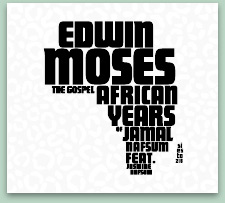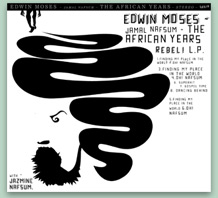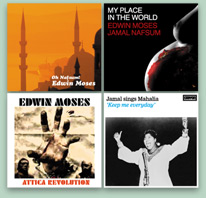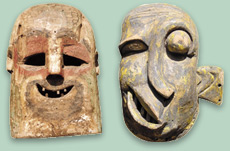records
Listen and read all about EM evolution. Select a LP picture and enjoy it!!!
LP
records


We know this is not a great sleeve, but anyway this outline contains a number of elements the band wanted to use: the map of Africa, the funny letters (which were included later on) and some other things... The title of the recording, you see, was not so clear in that moment.

Among the treasures found to make 'The Gospel...' we have these four singles, original from Edwin Moses: 'Of Nafsum' with a mosque in the sleeve; 'My place in the world', the map of Africa on the abdomen of a pregnant woman; 'Attica revolution', a hand asking desperately for help; and the picture of the unequalled Mahalia Jackson on the single where Edwin plays a country version of Keep me everyday.

The Moses family, who has already a good relationship with the impostor band, sent some objects that Edwin had sent to them during his trip to Africa. The family says it's Edwin himself who has made them, taking his first steps as a sculptor of masks... no comment.
All the way to get by
Hum... a great treatise about innocence age. Just imagine yourself walking in the forest and then... Directed by Nicolás Mendez.
If you can't see the video, link www.youtube.com/watch?v=mni-4_YeOhU
The gospel African years
Lost Years 1981-83
Edwin Moses / Jamal Nafsum
If we recapitulate the outstanding biography of Edwin Moses, there is a blank period from 1981 to 1983. It is easy to imagine that during this mysterious 24 month lapse, he entered into a state of existential fear that was possibly resolved by his conversion to Islam (he called it reversion as we are all created by God) , under the name of Jamal Nafsum in parallel to his unexpected artistic resurrection.
Now fortunately we are in the position to chart his whereabouts during the early eighties and even his persona may be characterised now. In fact we have discovered that our hero embarked on a pilgrimage through African lands that ultimately took him to Mecca to be consistent with the chosen path. Later he returned to his home country after a short stay in the South of Spain, particularly, in a US military base (Rota, Cadiz).
We need to remind you that Edwin had travelled before to Africa back in 1971 as chorus man together with his friend Wilson Pickett. Unfortunately, we could not visualise his distinctive anatomy in the documentary film that was recorded on March 6th in Ghana to seize the flair of the special concert celebrating the independence of this nation. Apart from Pickett other acts and legends participated in this key event: Santana, Ike & Tina Turner, The Staple Singers, Les McCann & Eddie Harris and Voices of East Harlem (he was indeed one of the anonymous voices of this band).
In 1981, Moses lost all sense of the real world but found the solution to his personal problems by embracing the Muslim faith. The African continent was a true calling to secure responses to inner questions and to subsequently abandon years of excess and evil (and his drinker's belly). He returned to Ghana ten years alter his first visit. In its capital, Accra, he spent four vibrant months in primitive local studies with native musicians and raw materials and instruments. He took the opportunity to get more deeply into gospel and also write other stuff that was inspired in the dark African polyphonic sounds.
It was in the summer of 1981 when Edwin had to abruptly leave the country as one of his best friends was involved in one of the numerous coup d'etat attempts (inspired by CIA?) More traces of him were found in his next stop, Brazzaville, Congo, that was then governed by a Marxist regime (Congo signed a treaty of friendship with the Soviet Union that year). The tough conditions did not particularly impress Edwin. As we all know he had strong convictions in Muslim faith and had adopted an extreme ascetic life. At this stage we need to clarify that Edwin was neither a taliban nor a fanatic embarked in an inexplicable crusade with strange ideas (i.e to crash planes). He was more into Sufism which is perceived as a lighter version of the Muslim religion. Sufis are seen as deviant innovators that have introduced a mystical interpretation of Islam, probably exposing a more tolerant doctrine. For example, the practitioners are allowed to drink wine and have sexual intercourse before marriage.. This philosophy has had striking effects in other well-known musicians as Terry Callier, Taj Mahal, Dollar Brand and African celebrities: Yossou N`Dour, Cheik L\xF4, Toumani Diabat\xE9 and Salif Keita.
Nevertheless, there is no evidence of creativity during the Congo days, six bizarre months that frustrate all biographers since any speculations are possible. Edwin Moses decided to cross the southern border and arrived to a "war of guerrillas" devastated country -Angola- to reach the promise land of South Africa where he got to know the hard conditions of overcrowded jails.
According to his brother, apartheid was perceived by Edwin as a thorn in his heart. Not strange for a sensitive US citizen, a conversed Muslim and a Black Power activist. He dared to cause some riots and was severely punished and tortured by the barbaric Johannesburg cops. Visits to police stations and detention centres were very frequent. Paradoxically his American passport ("nothing to be proud of", he once said) saved him of serious consequences and vengeance of ruthless policemen. Johannesburg was an earthly purgatory and sanatorium for him. A finer time for him was his short stay in Cape Town, where there was a milder version of apartheid. Residence of many good musicians his first contact there was Dollar Brand, that introduced him to some reputed souljazz musicians such as Mike Makahalemele, Zacks Nkosi and Sahitma Bea Benjamín. For unknown reasons he had to leave South Africa without warning (maybe to escape prosecution). Unfortunately he could not become acquainted with Nelson Mandela, a true reference and icon for Edwin.
After his stay in S. Africa, Edwin travelled to Tanzania, although his real preference Ethiopía, where there was a bubbling music scene. It was by 1982 in the town of Addis Abeba where he met the legendary Ethiopian soulman Mahmoud Ahmed. He joined efforts with him and recovered his inspiration and "deep south" landmark, as he previously did in the seventies. Finally in October 1982, Edwin Moses' pilgrimage ends in the Holy town of Mecca where he is redeemed as Jamal Nafsum.
The advent of a golden age was possible for him after this pinnacle moment. He was prepared to go back to the States as his life was "full of brightness and promise" but in reality he was exhausted and financially ruined. Fortuitously he recognised a childhood neighbour that was employed as a security guard in the US Embassy at Riad and his luck suddenly changed. Thanks to this affable person, Edwin managed to travel to the US army base of Rota in Spain and from there to Granada, Andalucia where he stayed for 45 days (according to reliable sources the mother of one of the current band line-up members got to know him quite closely but there are gaps in recollections, you know...).
Finally on February 1983, Jamal Nafsum took a plane destination South of Florida and from there he headed to Chicago by train. To be continued.
By LUIS LAPUENTE & JOS\xC9 A. CASTILLO
Songs
- my place in the world

- it's time


- a brand new day

- be free

- keep me everyday
- not so bad

- we're not going back

- all the way to get by


- black working class

- evening sun

- you've got to feel it

- attica revolution


- oh, nafsum!

Credits
Band: Pedro Vigil, Pablo Errea, Guzmán Argüello, Manuel Molina, Eduardo García Salueña, Agustín Lara, Juan Antonio Martínez
Produced by: Paco Loco & Edwin Moses. Recorded at 'Teisco' (Gijón, 2005) and mixed by Paco Loco at his studio (Cádiz, 2006).
Guest stars: Gary Louris, The Children of Isael Mass Choir, Saxattack horns
Design: Pablo Errea




